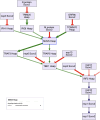The Gene Ontology knowledgebase in 2023
- PMID: 36866529
- PMCID: PMC10158837
- DOI: 10.1093/genetics/iyad031
The Gene Ontology knowledgebase in 2023
Abstract
The Gene Ontology (GO) knowledgebase (http://geneontology.org) is a comprehensive resource concerning the functions of genes and gene products (proteins and noncoding RNAs). GO annotations cover genes from organisms across the tree of life as well as viruses, though most gene function knowledge currently derives from experiments carried out in a relatively small number of model organisms. Here, we provide an updated overview of the GO knowledgebase, as well as the efforts of the broad, international consortium of scientists that develops, maintains, and updates the GO knowledgebase. The GO knowledgebase consists of three components: (1) the GO-a computational knowledge structure describing the functional characteristics of genes; (2) GO annotations-evidence-supported statements asserting that a specific gene product has a particular functional characteristic; and (3) GO Causal Activity Models (GO-CAMs)-mechanistic models of molecular "pathways" (GO biological processes) created by linking multiple GO annotations using defined relations. Each of these components is continually expanded, revised, and updated in response to newly published discoveries and receives extensive QA checks, reviews, and user feedback. For each of these components, we provide a description of the current contents, recent developments to keep the knowledgebase up to date with new discoveries, and guidance on how users can best make use of the data that we provide. We conclude with future directions for the project.
Keywords: Gene Ontology; gene annotation; gene function; knowledge graphs; knowledgebase.
© The Author(s) 2023. Published by Oxford University Press on behalf of The Genetics Society of America.
Conflict of interest statement
Conflicts of interest The authors declare no conflicts of interest.
Figures



References
Publication types
MeSH terms
Substances
Grants and funding
- U24 HG002659/HG/NHGRI NIH HHS/United States
- U24 HG002223/HG/NHGRI NIH HHS/United States
- UL1 TR001412/TR/NCATS NIH HHS/United States
- R01 HL064541/HL/NHLBI NIH HHS/United States
- U24 HG000330/HG/NHGRI NIH HHS/United States
- U24 HG010859/HG/NHGRI NIH HHS/United States
- U24 HG011851/HG/NHGRI NIH HHS/United States
- MR/W024233/1/MRC_/Medical Research Council/United Kingdom
- U24 HG012198/HG/NHGRI NIH HHS/United States
- U24 HG012212/HG/NHGRI NIH HHS/United States
- BB/T010541/1/BB_/Biotechnology and Biological Sciences Research Council/United Kingdom
- U24 HG001315/HG/NHGRI NIH HHS/United States
- WT_/Wellcome Trust/United Kingdom
- U41 HG000739/HG/NHGRI NIH HHS/United States
- 218236/Z/19/Z/WT_/Wellcome Trust/United Kingdom
- MR/N030117/1/MRC_/Medical Research Council/United Kingdom
- U41 HG002273/HG/NHGRI NIH HHS/United States
- P41 HD064556/HD/NICHD NIH HHS/United States
- U24 HG007822/HG/NHGRI NIH HHS/United States
- BB/S01781X/1/BB_/Biotechnology and Biological Sciences Research Council/United Kingdom

